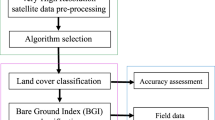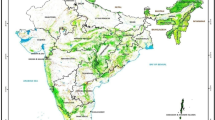Abstract
India, a mega-diverse country, possesses a wide range of climate and vegetation types along with a varied topography. The present study has classified forest types of India based on multi-season IRS Resourcesat-2 Advanced Wide Field Sensor (AWiFS) data. The study has characterized 29 land use/land cover classes including 14 forest types and seven scrub types. Hybrid classification approach has been used for the classification of forest types. The classification of vegetation has been carried out based on the ecological rule bases followed by Champion and Seth’s (1968) scheme of forest types in India. The present classification scheme has been compared with the available global and national level land cover products. The natural vegetation cover was estimated to be 29.36 % of total geographical area of India. The predominant forest types of India are tropical dry deciduous and tropical moist deciduous. Of the total forest cover, tropical dry deciduous forests occupy an area of 2,17,713 km2 (34.80 %) followed by 2,07,649 km2 (33.19 %) under tropical moist deciduous forests, 48,295 km2 (7.72 %) under tropical semi-evergreen forests and 47,192 km2 (7.54 %) under tropical wet evergreen forests. The study has brought out a comprehensive vegetation cover and forest type maps based on inputs critical in defining the various categories of vegetation and forest types. This spatially explicit database will be highly useful for the studies related to changes in various forest types, carbon stocks, climate-vegetation modeling and biogeochemical cycles.










Similar content being viewed by others
References
Anderson, J.R., Hardy, E.E., Roach, J.T., & Witmer, R.E. (1976). A land use and land cover classification system for use with remote sensor data. U.S. Geological Survey Professional Paper 964, USGS, USA. http://landcover.usgs.gov/pdf/anderson.pdf.
Banger, K., Tian, H. Q., & Tao, B. (2013). Contemporary land cover and land use patterns estimated by different regional and global datasets in India. Journal of Land Use Science. doi:10.1080/1747423X.2013.858786.
Bartholome, E., & Belward, A. S. (2005). GLC2000: a new approach to global land cover mapping from Earth observation data. International Journal of Remote Sensing, 26(9), 1959–1977.
Bontemps, S., Defourny, P., Bogaert, E.V., Arino, O., Kalogirou, V. & Perez, J.R. (2011). GLOBCOVER 2009: Products Description and Validation Report (ESA and UCLouvain). http://ionia1esrin.esa.int/docs/GLOBCOVER2009 (accessed on 14th November 2013).
Champion, H. G., & Seth, S. K. (1968). A revised survey of the forest types of India. Delhi: Manager of Publications.
Chavez PS (1996). Image-based atmospheric corrections – revisited and improved. Photogrammetric Engineering & Remote Sensing, 62, 1025–1036.
Chhabra, A., & Panigrahy, S. (2011). Analysis of spatio-temporal patterns of leaf area index in different forest types of India using high temporal remote sensing data. International Archives of the Photogrammetry, Remote Sensing and Spatial Information Sciences, XXXVIII-8/W20, 119–124
Cihlar, J. (2000). Land cover mapping of large areas from satellites: status and research priorities. International Journal of Remote Sensing, 21, 1093–1114.
FAO (2010). State of the World’s Forests, Food and Agriculture Organisation of the United Nations, Rome
FAO (2012). State of the World’s Forests, Food and Agriculture Organisation of the United Nations, Rome
FSI. (2009). State of Forest Report. Dehra Dun: Forest Survey of India.
FSI. (2011). State of Forest Report. Dehra Dun: Forest Survey of India.
FSI. (2013). State of Forest Report. Dehra Dun: Forest Survey of India.
Fearnside, P. M., & Barbosa, R. I. (2004). Accelerating deforestation in Brazilian Amazonia: towards answering open questions. Environmental Conservation, 31, 7–10.
Franklin, S. E., & Wulder, M. A. (2002). Remote sensing methods in medium spatial resolution satellite data land cover classification of large areas. Progress in Physical Geography, 26, 173–205.
Gadgil, M., & Meher-Homji, V.M. (1986). Localities of great significance to conservation of India’s biological diversity. Proceedings of Indian Academy of Sciences (Animal Sciences/Plant Sciences), (Suppl.), 165–180.
Guisan, A., & Zimmerman, N. (2000). Predictive habitat distribution models in ecology. Ecological Modeling, 135, 147–186.
Hansen, M. C., Defries, R. S., Townshend, J. R. G., & Sohlberg, R. (2000). Global land cover classification at 1 km spatial resolution using a classification tree approach. International Journal of Remote Sensing, 21, 1331–1364.
Hansen, M., Potapov, P., Moore, R., Hancher, M., Turubanova, S., Tyukavina, A., Thau, D., et al. (2013). High-resolution global maps of 21st century. Science, 342, 850–853.
Holdridge, L. R. (1947). Determination of world plant formations from simple climatic data. Science, 105, 367–368.
http://bhuvan.nrsc.gov.in/ (accessed on 12th November 2014).
http://censusindia.gov.in/ (accessed on 14th October 2014).
http://glcf.umd.edu/research/portal/geocover/ (accessed on 20th January 2013).
http://www.globallandcover.com (accessed on 11th December 2014).
http://earth.google.com/ (accessed on 4th November 2014).
http://reverb.echo.nasa.gov/reverb/ (accessed on 4th January 2015).
IIRS. (2004). Biome level characterization of Indian vegetation using IRS WiFS data. Dehradun: Indian Institute of Remote Sensing.
Joshi, P. K., Roy, P. S., Singh, S., Agrawal, S., & Yadav, D. (2006). Vegetation cover mapping in India using multi-temporal IRS Wide Field Sensor (WiFS) data. Remote Sensing of Environment, 103(2), 190–202.
Jung, M., Henkel, K., Herold, M., & Churkina, G. (2006). Exploiting synergies of global land cover products for carbon cycle modeling. Remote Sensing of Environment, 101, 534–553.
Lillesand, T. M., & Kiefer, R. W. (1999). Remote sensing and image interpretation. New York: John Wiley and Sons.
Lund, H.G. (2012). National Definitions of Forest/Forestland Listed by Country. Forest information Service. http://home.comcast.net/~gyde/lundpub.htm (accessed on 30th January 2015).
Loveland, T. R., Reed, B. C., Brown, J. F., Ohlen, D. O., Zhu, Z., Yang, L. W. M. J., & Merchant, J. W. (2000). Development of a global land cover characteristics database and IGBP DISCover from 1 km AVHRR data. International Journal of Remote Sensing, 21(6–7), 1303–1330.
Margules, C. R., & Pressey, R. L. (2000). Systematic conservation planning. Nature, 405(6783), 243–253.
Mueller-Dombois, D., & Ellenberg, H. (1974). Aims and methods of vegetation ecology. New York: John Wiley and Sons.
NRSA. (1985). Forest cover assessment of India using satellite remote sensing data during 1972–1975 and 1980–1982 periods. National Remote Sensing Agency, Hyderabad, India: Technical Report.
NRSC. (2013). Natural resources census: national land use and land cover mapping using multi-temporal AWiFS data. National Remote Sensing Centre, Hyderabad, India: Technical report.
Rabus, B., Eineder, M., Roth, A., & Balmer, R. (2003). The shuttle radar topography mission-a new class of digital elevation models acquired by spaceborne radar. ISPRS Journal of Photogrammetry and Remote Sensing, 57, 241–262.
Ravindranath, N. H., Murthy, I. K., Joshi, P., Upgupta, S., Mehra, S., & Srivastava, N. (2014). Forest area estimation and reporting: implications for conservation, management and REDD+. Current Science, 106, 1201–1206.
Reddy, C. S., Pujar, G. S., Sudhakar, S., Shilpa, B., Sudha, K., Trivedi, S., Gharai, B., & Murthy, M. S. R. (2008). Mapping the vegetation types of Andhra Pradesh, India using remote sensing. Proceedings of Andhra Pradesh Akademy of Sciences, 12, 14–23.
Reddy, C. S., Harikrishna, P., & Ravikiran, A. (2011). Mapping the vegetation types of Rajasthan, India using remote sensing data. Journal of Environmental Research and Management, 2, 1–9.
Reddy, C. S., Dutta, K., & Jha, C. S. (2013a). Analysing the gross and net deforestation rates in India. Current Science, 105(11), 1492–1500.
Reddy, C. S., Sreelekshmi, S., Jha, C. S., & Dadhwal, V. K. (2013b). National assessment of forest fragmentation in India: Landscape indices as measures of the effects of fragmentation and forest cover change. Ecological Engineering, 60, 453–464.
Reddy, C. S., Khuroo, A. A., Harikrishna, P., Saranya, K. R. L., Jha, C. S., & Dadhwal, V. K. (2014). Threat evaluation for biodiversity conservation of forest ecosystems using geospatial techniques: a case study of Odisha, India. Ecological Engineering, 69, 287–303.
Reddy, C. S., Rajashekar, G., Harikrishna, P., Jha, C. S., & Dadhwal, V. K. (2015). Multi-source and multi-date mapping of deforestation in Central India (1935–2010) and its implication on standing phytomass carbon pool. Ecological Indicators, 57, 219–227.
Rodgers, W. A., & Panwar, H. S. (1988). Planning a Protected Area Network in India. Vol. 1: Technical Report. Dehradun: Wildlife Institute of India.
Romijn, E., Ainembabazi, J. H., Wijaya, A., Herold, M., Angelsen, A., Verchot, L., & Murdiyarso, D. (2013). Exploring different forest definitions and their impact on developing REDD+ reference emission levels: a case study for Indonesia. Environmental Science and Policy, 33, 246–259.
Roy, P. S., Joshi, P. K., Singh, S., Agarwal, S., Yadav, D., & Jegannathan, C. (2006). Biome mapping in India using vegetation type map derived using temporal satellite data and environmental parameters. Ecological Modeling, 197(1), 148–158.
Roy, P. S., Kushwaha, S. P. S., Murthy, M. S. R., Roy, A., Kushwaha, D., Reddy, C. S., Behera, M. D., Padalia, H., Mathur, V. B., Singh, S., Jha, C. S., & Porwal, M. C. (2012). Biodiversity characterisation at landscape level: national assessment (pp. 1–254). Dehra Dun: Indian Institute of Remote Sensing. ISBN 81-901418-8-0.
Roy, P. S., Behera, M. D., Murthy, M. S. R., Roy, A., Singh, S., Kushwaha, S. P. S., Jha, C. S., Sudhakar, S., Joshi, P. K., Reddy, C. S., et al. (2015a). New vegetation type map of India prepared using satellite remote sensing: comparison with global vegetation maps and utilities. International Journal of Applied Earth Observation and Geoinformation, 39, 142–159.
Roy, P. S., et al. (2015b). Development of decadal (1985–1995–2005) land use and land cover database for India. Remote Sensing, 7(3), 2401–2430.
Sun, W., Liang, S., Xu, G., Fang, H., & Dickinson, R. (2008). Mapping plant functional types from MODIS data using multisource evidential reasoning. Remote Sensing of Environment, 112(3), 1010–1024.
Tian, H., Banger, K., Bo, T., & Dadhwal, V. K. (2014). History of land use in India during,1880–2010. Large-scale land transformations reconstructed from satellite data and historical archives. Global and Planetary Change, 121, 78–88.
UNFCCC. (2001). Seventh Conference of Parties: The Marrakech Accords (UNFCCC Secretariat, Bonn); http://www.unfccc.int. Accessed 18 Jan 2013.
Van der Maarel, E. (2005). Vegetation ecology. USA: Blackwell Science Ltd. ISBN 0-632-05761-0.
Westhoff, V. & Van der Maarel, E., (1978). The Braun-Blanquet approach. In: Classification of Plant Communities (ed. R.H. Whittaker), 2nd ed., pp. 287–297. Junk, The Hague
Acknowledgments
The present work has been carried out as part of ISRO’s National Carbon Project. We gratefully acknowledge ISRO-DOS Geosphere Biosphere Programme for supporting this research. We thank Prof. G.H. Dar, Dr. Anzar Khuroo, University of Kashmir, Srinagar, Prof. K.C. Sharma, Central University of Rajasthan, Ajmer, Dr. S.L. Meena, Botanical Survey of India, Jodhpur and Dr. P.S. Nagar, University of Baroda, Vadodara for valuable comments. We are thankful to all collaborators for providing field data. We are thankful to the State Forest Departments of India for the necessary field support and facilities. We also thank the editor and anonymous reviewers for their comments and suggestions, which helped us to improve the manuscript.
Author information
Authors and Affiliations
Corresponding author
Rights and permissions
About this article
Cite this article
Reddy, C.S., Jha, C.S., Diwakar, P.G. et al. Nationwide classification of forest types of India using remote sensing and GIS. Environ Monit Assess 187, 777 (2015). https://doi.org/10.1007/s10661-015-4990-8
Received:
Accepted:
Published:
DOI: https://doi.org/10.1007/s10661-015-4990-8




